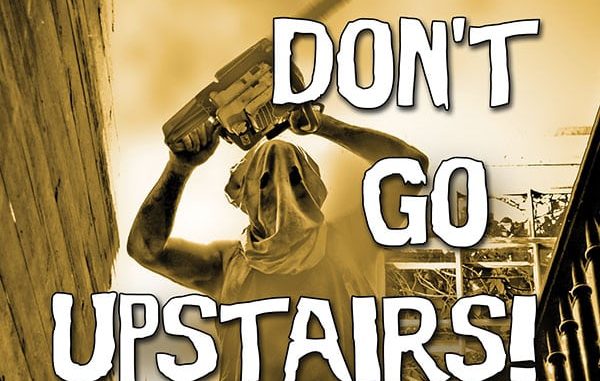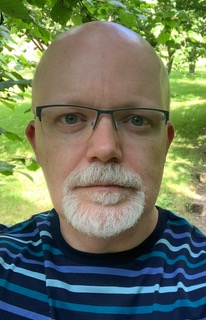
Review Fix chats with “Don’t Go Upstairs! A Room-by-Room Tour of the House in Horror Movies†author Clever Patterson, who discusses the creation process behind the book, the challenges and so much more.
About the Author:

Cleaver Patterson is an author, journalist, and film critic based in South West London. He has written for numerous periodicals including The Sunday Times Magazine, Rue Morgue, Scream, Starburst and Video Watchdog.
About the Book:
Throughout cinematic history, the buildings characters inhabit—whether stately rural mansions or inner-city apartment blocks—have taken on extra dimensions, often featuring as well developed characters themselves. Nowhere is this truer than in the horror film, where familiar spaces—from chaotic kitchens to forgotten attics to overgrown greenhouses—become settings for diabolical acts or supernatural visitations.
Showing readers through a selection of prime movie real estate, this book explores how homes come to life in horror with an analysis of more than sixty films, including interviews and insights from filmmakers and scholars, along with many rare stills. From the gruesome murder in the hallway of The House by the Cemetery (1981) to the malevolent haunting in the nursery of Eel Marsh House in The Woman in Black (2012), no door is left unopened.
Review Fix: What inspired this book?
Cleaver Patterson: I’ve always loved houses and interiors. I’m fascinated looking at other people’s homes online and in magazines. When I was thinking of possible subjects for a book I started to ask why, to the best of my knowledge, no one had ever done a book looking at the role houses play in films, and in particular horror films. A house to live in is one of the few things that almost everyone has in common – even the most diabolical movie maniac needs somewhere to call home. When I had this basis, the book just grew from there. I thought that breaking the house into its various rooms and looking at how each one appeared in various films would make it more interesting, as well as making the writing process a little less intimidating.
Review Fix: What was your research process like?
Patterson: I have to admit it was all reasonably straightforward. I took each room in the house – like the kitchen, the bedroom or the hallway – and then tried to find horror films where the said room featured heavily or where a key scene took place. I have masses of horror films on dvd and blu-ray and have been watching films for years, so it wasn’t hard to come up with ones which featured the rooms. I also have a vast collection of vintage film magazines and books with reviews going back decades, which helped enormously with quotes and background information on the films. So altogether I have to admit that research mainly consisted of watching seventy five horror films back to back, and reading lots of old movie magazines, which wasn’t exactly arduous.
Review Fix: What’s your favorite part of the book?
Patterson: A hard question as for many of the rooms I featured I included examples from films which I love. But if it was purely on a basis of the room itself I’d have to say the chapter on The Conservatory and Greenhouse. There’s something otherworldly and slightly sinister about those old fashioned Victorian conservatories / conservatories which I just love, like the one in Helen’s lonely country house in Symptoms (1974). Someday I’d love to have an old house with a glass and steel room like that, where you could while away the hours in an environment which brings nature into your home. I also like the interview I did with the director Abner Pastoll about his brilliant chiller Road Games (2015). His experiences of making the film, what went into its production behind the scenes and the part the house played in the film, made the whole process of filmmaking come alive.
Review Fix: What are some of your favorite horror movies?
Patterson: I’m a sucker for vintage horror. I love old Hollywood ones, the more obscure the better. Things like 1933’s wonderful Murders in the Zoo (which has one of the most disturbing opening scenes in horror cinema) or 1935’s Werewolf of London. No film from that period seemed complete without a crazy laboratory with endless Bunsen burners, glass test tubes and cutting edge electronic generators, all of which simply added to the atmosphere. I also love anything from Hammer or Amicus. I could watch almost any of their films. Even their worst ones were better than many of the horror films produced today.
Review Fix: Any awful guilty pleasure favorites?
Patterson: My guilty pleasure favourite has to be director Douglas Hickox’s 1973 gem Theatre of Blood, with Vincent Price. It’s terribly camp and over-the-top. But Price took it all so seriously that it never looses its ability to chill. And it has the most marvellous cast of English eccentrics. It also captures that inexplicable feeling movies and TV shows set in London during that period have. It’s something you just can’t put your finger on. Something magical just like the film itself. I also love Boris Karloff in The Sorcerers from 1967. Completely off-the-wall, but fantastic fun.
Review Fix: Most underrated horror flick ever?
Patterson: Am I allowed two? I have to say Hammer’s The Satanic Rites of Dracula from 1973, which everyone seems to dismiss as one of their weaker vampire entries, but which I love. Again it has that London feeling, as well as the delectable Joanna Lumley. So what’s not to like. Also an obscure horror documentary feature from the 1984 called Terror in the Aisles. It’s really hard to get a copy now, but is well worth seeing if you can track it down. It’s basically a compilation of dozens of themed shock sequences from some of cinema’s most iconic chillers, interspersed with witty asides from hosts Donald Pleasence and Nancy Allen. A bit like I’d imagine a film based on my book could look like.
Review Fix: Any challenges?
Patterson: I limited myself to five films per room, so one of the biggest challenges was deciding which films to leave out. Afterwards people said why didn’t you include this film or that one, so maybe there’s enough scope for a sequel – ‘Don’t Go Upstairs – The Second Story!’? The other challenge was the fact that with my publisher McFarland you have to do a lot of background things yourself which might otherwise be handled by the publishers themselves if it’s a bigger company. So the whole process was much more hands on which was rewarding. For instance I had to find and provide all my own photos for the book. In the end though I really enjoyed that aspect – finding stills on eBay etc, or using some of my own photography. It gave me a great sense of achievement as well as some wonderful stills and vintage lobby cards to add to my collection. What did you learn that you weren’t expecting? To be honest the biggest things I learnt were about myself, more than the book’s subject etc. Only once I’d completed the book did I realise my extensive knowledge of obscure and odd horror films, which seem to have passed by even the most avid film buffs. I also discovered a sense of perseverance which I wasn’t aware I had. Anyone who tells you that writing is easy, has clearly never done it seriously. Writing the book was one of the most challenging things I’ve ever done, but the sense of achievement and pride once I held the finished work in my hands was, and still is, one of the best feelings ever. How do you want the book to be remembered? As the first real estate guide to horror cinema.
Review Fix: Why should a horror fan read this?
Patterson: I’d like to think the book would make horror fans look at the films included – whether they’re old favourites or new discoveries – from a different angle, hopefully highlighting some point they may have missed. It’d be good if it also encouraged people to rewatch some other horror classics so that they can see how houses and architecture play a part in them. I hope that the book will be of interest to general films fans too. Though obviously, by the subject’s nature, there are gory and violent films included, I tried to keep the more explicit details to a minimum, so I think there’s something in the book to appeal to all tastes.
Review Fix: What’s next?
Patterson: I did have another couple of ideas for potential books on horror film subjects, which I had mooted to publishers, and which I’d still like to do. At the moment however I’m in the middle of a two year Masters degree in Screenwriting, which I hope may lead to other projects in the future. I’ve a few ideas which I think would work wonderfully on screen, so who knows where that might lead.
Review Fix: Anything else you’d like to add?
Patterson: It sounds cliché, but people always say the only way to write a book is to stop talking about it and sit down and do it, which is true. I’m living proof. You just have to get on with it.


Leave a Reply